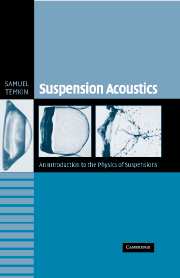Book contents
- Frontmatter
- Contents
- List of Figures and Tables
- Preface
- 1 Preliminaries
- 2 Conservation Equations
- 3 Rigid-Particle Heat Transfer at Re ≪ 1
- 4 Translational Motion at Re ≪ 1
- 5 Shape Deformations
- 6 Volume Pulsations
- 7 Thermodynamics of Suspensions
- 8 The Two-Phase Model
- 9 Sound Propagation in Suspensions
- 10 Applications and Extensions
- Appendix A Material and Transport Properties of Some Substances at 1 atm and 20°C
- Appendix B Useful Formulas from Vector Analysis
- Appendix C Explicit Expressions for Some Quantities in Spherical Polar Coordinates
- Appendix D Some Properties of the Spherical Bessel Functions
- Appendix E Legendre Polynomials
- Bibliography
- Author Index
- Subject Index
- Symbol Index
9 - Sound Propagation in Suspensions
Published online by Cambridge University Press: 25 August 2009
- Frontmatter
- Contents
- List of Figures and Tables
- Preface
- 1 Preliminaries
- 2 Conservation Equations
- 3 Rigid-Particle Heat Transfer at Re ≪ 1
- 4 Translational Motion at Re ≪ 1
- 5 Shape Deformations
- 6 Volume Pulsations
- 7 Thermodynamics of Suspensions
- 8 The Two-Phase Model
- 9 Sound Propagation in Suspensions
- 10 Applications and Extensions
- Appendix A Material and Transport Properties of Some Substances at 1 atm and 20°C
- Appendix B Useful Formulas from Vector Analysis
- Appendix C Explicit Expressions for Some Quantities in Spherical Polar Coordinates
- Appendix D Some Properties of the Spherical Bessel Functions
- Appendix E Legendre Polynomials
- Bibliography
- Author Index
- Subject Index
- Symbol Index
Summary
Introduction
In the last chapter, we used the two-phase model of suspensions to consider several examples of sound propagation in suspensions. The examples were chosen to illustrate the main aspects of the propagation of sound waves, but they refer to some physically unrealistic conditions, such as the isothermal aerosol. Of course, the results obtained for those conditions may apply in limited portions of the frequency range; but, generally speaking, they leave out important effects. For example, as we saw in Chapter 6, the neglect of thermal effects on the pulsations of bubbles is not warranted at frequencies that are below resonance.
From a fundamental point of view, it is desirable to study sound propagation in suspensions without imposing such restricting conditions. To be sure, the two-phase model allows such a study, but the inclusion of all of the effects that play a role in the propagation would require the two complete sets of equations. While the system can be easily solved for linear motions, it is evident that its solution would generally require numerical computations and would produce results difficult to interpret. Furthermore, results valid for a wide range of frequencies would be obtained only if the particulate force and heat transfer rate are specified in their most general forms, thus increasing the complexity of the system.
In this chapter, we consider the propagation of sound waves in dilute suspensions using various techniques, models, and approximations.
- Type
- Chapter
- Information
- Suspension AcousticsAn Introduction to the Physics of Suspensions, pp. 267 - 317Publisher: Cambridge University PressPrint publication year: 2005



